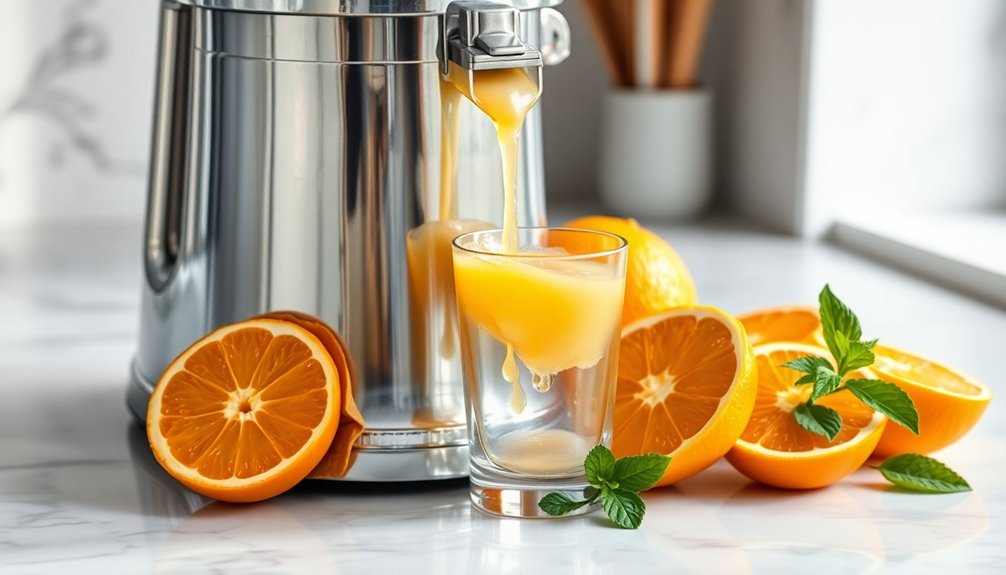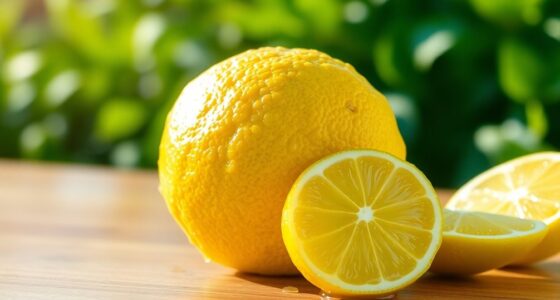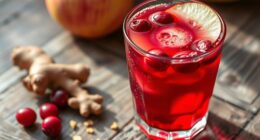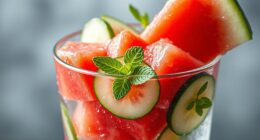To juice oranges in a juicer, start by washing them thoroughly to remove dirt. Peel the oranges and chop them into smaller sections for easy feeding into the juicer. Process a few pieces at a time to ensure you maximize the yield. Once you've collected the fresh juice, enjoy it immediately for the best flavor and nutrients. Don't forget to clean your juicer afterward to keep it in top shape. You'll find more tips on juicing ahead!
Key Takeaways
- Wash fresh oranges thoroughly to remove dirt and residues before juicing.
- Peel and chop the oranges into smaller sections that fit your juicer's chute.
- Feed orange pieces into the juicer gradually, allowing full processing for maximum juice yield.
- Collect the freshly squeezed juice in a container and enjoy immediately for the best flavor and nutrients.
- Clean the juicer components promptly to maintain hygiene and ensure optimal performance for future use.

Juicing oranges is a refreshing way to enjoy their vibrant flavor and health benefits. When you decide to juice at home, you're not just treating yourself to a delicious beverage; you're also giving your body a natural boost. Freshly squeezed orange juice is packed with vitamins and nutrients, especially vitamin C, which can help boost immunity and keep you feeling great.
Let's walk through the simple steps to get that delicious juice flowing.
Start by washing fresh oranges thoroughly under running water. This step is crucial because it helps remove any dirt or residues on the skin that could end up in your juice. Remember, you're aiming for pure, clean flavor.
Once they're washed, you can proceed to peel the oranges. If you find that the oranges are large, it might be necessary to chop them into smaller sections. This makes them easier to fit into the juicer chute, ensuring effective extraction and maximizing your yield of freshly squeezed orange juice.
Now, you're ready to juice! Feed the orange pieces into the juicer a few at a time. It's important to allow the machine to process each piece fully before adding more. This way, you'll get the most out of each orange, making sure to extract all that delicious juice while minimizing waste.
As you juice, keep an eye out for any seeds that might slip through. If you spot any, go ahead and remove them to keep your juice smooth and enjoyable.
Once you've juiced all your oranges, collect the freshly extracted juice in a container. It's best enjoyed immediately, as this ensures you savor the peak flavor and nutrient retention. If you prefer, you can chill it for a short while in the fridge, but don't let it sit too long; the fresher it is, the better the health benefits you'll reap.
You can also consider adding a little zest to your drink by incorporating some finely grated orange peel. This not only enhances the flavor but also adds additional nutrients.
After you're done juicing, make sure to clean the juicer components promptly. This is essential for maintaining hygiene and ensuring optimal performance for your future juicing sessions. A quick wash will prevent any leftover residue from affecting the taste of your next batch.
Frequently Asked Questions
Do You Have to Peel Oranges Before Juicing Them in a Juicer?
You don't have to peel oranges before juicing them, but it's a good idea.
Leaving the peel on can introduce bitterness from the pith, affecting your juice's flavor. Peeling also helps prevent clogging, especially in slower juicers.
If you're using a blender, peeling is essential for a smoother texture. Plus, opting for seedless varieties can make the process easier, ensuring you get the best-tasting juice without any unwanted interruptions.
Can You Juice Oranges in a Regular Juicer?
Absolutely, you can indulge in the delightful experience of juicing oranges with a regular juicer.
Just make sure your juicer welcomes citrus fruits for optimal extraction. Peel the oranges and slice them if needed, ensuring they fit comfortably in the chute.
Feed them in slowly, giving your juicer time to work its magic.
How to Juice an Orange Using a Juicer?
To juice an orange using a juicer, start by washing the oranges under cool water to eliminate dirt.
Peel them, remove any seeds, and chop them if necessary for your juicer's chute.
Feed the pieces into the juicer, allowing it to extract the juice efficiently.
Collect the juice in a container, discarding any pulp if you prefer a smoother texture.
Enjoy your fresh orange juice right away for the best taste and nutrients!
What Is the Trick to Juicing?
Ever wondered if there's a secret to juicing? The trick lies in choosing ripe, firm fruits and prepping them properly.
You'll want to wash them thoroughly to eliminate any dirt. Cutting them in half makes it easier for your juicer to extract every drop.
Feed the pieces in slowly, letting the machine work its magic. Lastly, collect the juice right away to enjoy that fresh taste without losing quality.
Conclusion
Now that you know how to juice oranges in a juicer, you can transform those vibrant fruits into a refreshing elixir that brightens your day. Just like the sun brings warmth and light, a glass of fresh orange juice can uplift your spirits and energize your morning. So, don't hesitate—grab those oranges and let your juicer work its magic. Enjoy every sip and savor the sweetness of your hard work, knowing you've created something truly delightful!
Cindy thoroughly researches juicing trends, techniques, and recipes to provide readers with practical advice and inspiration. Her writing style is accessible, engaging, and designed to make complex concepts easy to understand. Cindy’s dedication to promoting the advantages of juicing shines through her work, empowering readers to make positive changes in their lives through the simple act of juicing.











